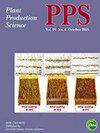Variation in antioxidant capacity of the seven azuki bean (Vigna angularis) varieties with different seed coat color
IF 1.3
3区 农林科学
Q2 AGRONOMY
引用次数: 1
Abstract
ABSTRACT Azuki bean (Vigna angularis) is a small red bean commonly used in Japanese cuisine from ancient time. The most common azuki bean seed is red, but there are black, grey, brown, green, straw-colored, white, and various flecked varieties. We evaluated the total antioxidant capacity and phytochemical phenolics profiles of seven azuki bean varieties in relation to their seed coat color according to the L*a*b* system using a color-difference meter. Not the cotyledons but the seed coat of all the varieties, except the white variety, showed antioxidant capacity (DPPH radical-scavenging activity). In the extracts obtained with 0.4% trifluoroacetic acid using the whole seeds without grinding, a wide range of antioxidant capacity from 36.2 to 2.8 μmol Trolox eq./g DW was obtained. The antioxidant capacity in the azuki bean was localized at the seed coat, and correlated positively with the total phenolics content and negatively with the color lightness (L*). Anthocyanin was present in only three darker varieties, Kuro-azuki, Shimofuri-azuki and Nezumi-azuki. Tamba-dainagon, the most popular red colored variety, and other three varieties contained no anthocyanin. However, these varieties without anthocyanin, except for one white variety, clearly showed antioxidant capacity. The antioxidative capacity of the deep colored azuki bean was much higher than that of light colored azuki bean. The azuki seed coat is revealed as an effective potential source of natural antioxidants. GRAPHICAL ABSTRACT七个不同种皮颜色天青豆品种抗氧化能力的变化
小豆(Vigna angularis)是一种小红豆,自古以来就常用于日本菜中。最常见的天青豆种子是红色的,但也有黑色、灰色、棕色、绿色、稻草色、白色和各种有斑点的品种。我们使用色差仪根据L*a*b*系统评估了七个天青豆品种的总抗氧化能力和植物化学酚类物质与种皮颜色的关系。除白色品种外,所有品种的子叶和种皮均表现出抗氧化能力(DPPH自由基清除活性)。在使用0.4%三氟乙酸获得的提取物中,使用未研磨的整个种子,抗氧化能力范围从36.2到2.8 μmol Trolox当量/g DW。天青豆的抗氧化能力位于种皮,与总酚含量呈正相关,与色泽(L*)呈负相关。花青素只存在于三个较暗的品种中,Kuro azuki、Shimofuri azuki和Nezumi azuki。Tamba dainagon是最受欢迎的红色品种,其他三个品种都不含花青素。然而,除了一个白色品种外,这些不含花青素的品种明显显示出抗氧化能力。深色天青豆的抗氧化能力远高于浅色天青豆。天青籽被认为是天然抗氧化剂的有效潜在来源。图形摘要
本文章由计算机程序翻译,如有差异,请以英文原文为准。
求助全文
约1分钟内获得全文
求助全文
来源期刊

Plant Production Science
农林科学-农艺学
CiteScore
5.10
自引率
4.00%
发文量
27
审稿时长
>36 weeks
期刊介绍:
Plant Production Science publishes original research reports on field crops and resource plants, their production and related subjects, covering a wide range of sciences; physiology, biotechnology, morphology, ecology, cropping system, production technology and post harvest management. Studies on plant production with special attention to resource management and the environment are also welcome. Field surveys on cropping or farming system are also accepted. Articles with a background in other research areas such as soil science, meteorology, biometry, product process and plant protection will be accepted as long as they are significantly related to plant production.
 求助内容:
求助内容: 应助结果提醒方式:
应助结果提醒方式:


